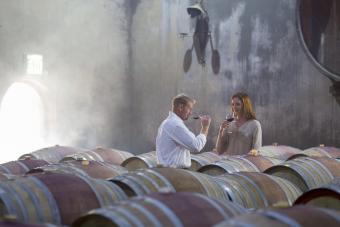
Even if you only dabble in wine, you've likely heard the word tannins thrown around. An important characteristic in many red wines, tannins contribute a specific mouthfeel and texture that gives balance to many wines.
What Are Tannins?
Tannins describe the resulting characteristics of of certain phenolic compounds. Their overwhelming traits are bitter and astringent characteristics that leave a mouth-drying sensation. Widely found in nature, they are most noticeable in things like black tea, rhubarb, walnuts, green tea, grapes, persimmons, dark chocolate, and coffee. If tannins are out of balance, they can come off overwhelmingly bitter, but when in balance, they are an important part of a flavor profile.
Tannins in Wine
When it comes to tannins in wine, they can come from the grapes and new oak barrels during the aging process. The grape skins, seeds, and stems all contribute varying amounts of tannins to the wine. Depending on the style the winemaker is going for, they will de-stem the grapes and avoid oak barrels to avoid excessive tannins. Different varietals also have varying amounts of tannins. Because tannins are in the skins and seeds, white wines that get directly pressed to separate the juice don't take on tannins and therefore don't have those astringent characteristics that red and orange wines can have.

How to Detect Tannins
While tannins in wine can be aggressive, they can also be velvety smooth when they've had the right amount of time to settle and bring balance to the wine. If you want to distinguish the tannins in your glass, sip and swish the wine around and let it coat your entire mouth. Do you notice an instant drying sensation? Or is it only after you swallow that there's a subtle lingering dryness? If you taste an overwhelming bitterness and experience a significant drying across your palate, the tannins will be assertive and potentially out of balance. The bitterness and astringency may remind you of biting into an unripe banana and drinking a strongly brewed black tea without milk or sugar.
How to Describe Tannins
There are a lot of descriptors for wine. A handful of them describe tannins and are useful to know when reading a wine description or describing a wine yourself. Overtly tannic wines that appear a bit out of balance could be described as aggressive or assertive. Young tannins that need more time to mellow could be described as green. In balance, tannins may be referred to as grippy. And tannins that have aged a significant amount of time and really changed the texture of the wine may be referred to as silky, velvety, elegant, or polished.
Low-Tannin Wines vs. High Tannin Wines
Some grape varieties have more tannins than others. Often, the more tannic wines will require a bit more time in bottle to come into balance and allow the tannins to take on a smoother texture.
Low-Tannin Wines
If you don't like the taste or texture that tannins contribute, stick to white wines or lower-tannin orange and red wines. Unless whites have some skin contact, they won't have tannins. A few red varietals that are low in tannins are gamay, St. Laurent, malbec, barbara, lambrusco, grenache, ciliegiolo, frappato, and schiava.
High-Tannin Wines
When tannins have had sufficient time to become all silky smooth and really make a wine special, they are a delight. Some wines that are known for their pronounced tannins include cabernet sauvignon, nebbiolo, tannat, tempranillo, mourvèdre, Bordeaux, shiraz, and sangiovese.
How to Pair Tannic Wines
Tannins need to be balanced by a richness found in the proteins and fat in red meat. That's why a classic pairing for a cab sauv or Bordeaux is a steak or braised beef dishes. Think about it as matching like with like. If you have a heavy hitter red like nebbiolo with brooding tannins, it's going to need to be paired with an equally big personality dish. Filet Mignon, beef bourguignon, polenta with roasted mushrooms, and beef tenderloin are all great pairings for tannic wines.
Understanding Tannins
Once you understand how tannins actually come across on your palate in terms of taste and texture, you can narrow in on certain grapes and styles and begin to grasp the ones that need that extra time to in bottle to smooth out. The structure that tannins give to some of the bigger, headier wines is a huge part of what makes them such a delight to drink after all those years sitting around developing.







